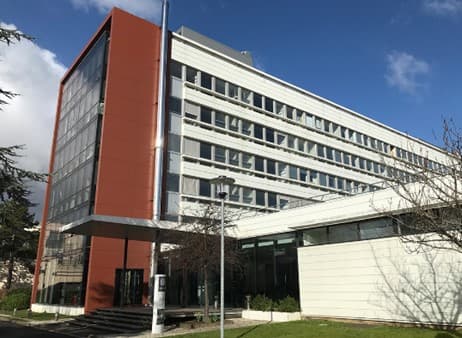
Use geothermal energy to decarbonize warehouses and offices
 Solar Impulse Foundation
Solar Impulse Foundation SLB
SLBSummary
Shallow geothermal, also called geoenergy, significantly reduces CO2 emissions to heat and cool buildings, and reduces energy consumption and operational costs
Context
This case-study has been developed in partnership with the Solar Impulse Foundation, which is promoting – through assessing, certifying and facilitating access to finance - the multitude of clean and profitable solutions currently available worldwide. Discover more of Solar Impulse Foundation’s labelled solutions here.
Committed to an ambitious CSR policy, including a 60% reduction in final energy consumption in buildings by 2050, Optic 2000 Group sought to reduce the carbon footprint of heating and cooling at its head office in Clamart, France. The building is more than 12,000 m2, comprising offices and an assembly workshop for around 450 employees.
The Group's objective was to reconcile cost and energy performance while guaranteeing optimal thermal comfort for employees. To respond to these challenges, Optic 2000 Group chose geoenergy, a local, abundant, and low-carbon resource located in the first 200 meters of the subsoil.
Figure 1: Optic 2000 project in summary

Solution
The systems for the exploitation of shallow geothermal resources are based on the principle that the temperature of soil/rock and groundwater is constant throughout the year at a particular depth. Shallow geothermal requires drilling vertically 10 to 200 meters into the ground to capture or dissipate heat (for heating or cooling, respectively).
Figure 2: Shallow geothermal types

For this thermal renovation project, Optic 2000 Group partnered with Celsius Energy, a subsidiary of SLB, which proposed a hybrid solution combining its geoenergy solution with the existing gas and cold unit systems.
Installed from March to December 2022, the solution is based on three pillars:
A closed pyramid-shaped geothermal energy exchanger, equipped with 21 U-shaped probes at a depth of 200 m, in which a heat transfer fluid circulates.
Figure 3: Geothermal energy exchanger drilling

Figure 4: 21 U-shaped probes at 200 m

A 500 kW connected heat pump enabling heat exchanges with the subsurface, supplying heat to the building in winter and extracting heat in the summer. Simultaneous heating and cooling are also possible.
Figure 5: Heat pump installation

A digital control platform minimizing electricity consumption by optimizing the operation of the subsurface equipment and the heat pumps connected to the building in real time. Digital control also guarantees system performance and reduces the maintenance of the connected heat pump.
Figure 6: Celsius Energy digital control platform

Impact
Climate impact
Targeted emissions sources
Scope 1: 71% reduction of heating and cooling emissions
Scope 2: 44% reduction of electricity purchased for cooling
Scope 3, Category 3: 53% reduction of gas purchase for heating
Decarbonization impact
For this specific project, the geothermal energy system can heat and cool the building while eliminating 71% of CO₂ emissions per kWh generated, compared to the benchmark solution (gas and chillers).
Business impact
Benefits
Green value added to the building By integrating a sustainable heating and cooling system, and complying with new French energy efficiency regulations, Optic 2000 has increased the real-estate value of the building.
Energy independence The energy source that the building uses is unlimited and 100% local, reducing dependency on imported fossil fuels, which are subject to price volatility.
No impact on productivity The installation of the shallow geothermal system had no impact on the company's employees or business activities due to:
The small footprint of the work area
An installation completed in just a few months
Employee comfort Geothermal energy is renewable and constant. It’s available all year long, day and night, regardless of weather conditions, and is not subject to intermittent supply like other renewable energy sources, such as solar and wind. It also ensures summer and winter comfort for employees.
A turnkey, remote-controllable solution A digital plug-and-play interface enables real-time management of the system’s energy consumption and performance. Using the interface via a computer or phone, Optic 2000’s energy manager can readily monitor data and optimize the system.
Savings With the system, the company aims to divide heating and cooling costs by at least two. Geothermal energy requires basic operational maintenance, as the installation lifespan ranges from 50 to 100 years.
Costs
The dimensioning of the geoenergy installation mainly depends on:
The building’s heating and cooling needs
Type of subsoil
Consequently, the cost depends on:
The number of wells
The heat pump power
For this project:
Initial Investment cost: €1.1M
Subsidies: €148K
Return on investment: 13 years (i)
Indicative abatement cost
USD $20-200/tCO2e (2022)
Impact beyond climate and business
Co-benefits
The absence of exterior equipment, such as an air-source heat pump or air-conditioning unit, makes it an aesthetic solution, with zero noise and visual impact.
The building is cooled without expelling hot air outside the building. Therefore, the solution does not contribute to the phenomenon of urban heat islands, promoting general well-being in public spaces.
For those reasons, it harmoniously complements urban renaturation measures.
Potential side-effects
None – the solution implemented relies on a team of experts to provide feasibility studies and design the systems (geologist, hydrogeologist, HVC engineers, data engineers, etc.). The feasibility studies enable the identification of potential risks before any project is carried out.
Implementation
Typical business profile
This solution is suitable for retrofit and new construction projects, preferably over 3,000 m2. It is a long-lasting, safe, and stable solution for different types of buildings, ranging from offices and condominiums, to factory settings or public buildings, such as schools or hospitals.
Approach
This project was developed with a turnkey solution, including pre-dimensioning, feasibility, execution, and operation.
Stakeholders involved
Project Leads: CSR group manager
Key parameters to consider
Solution maturity: It is a proven solution based on established technologies (Celsius Energy is an SLB [Schlumberger] subsidiary).
Lifetime: Borehole heat-exchanger: 50 to 100 years Ground source heat-pump: 20 years
Technical constraints or pre-requisites:
Business model: building > 3,000m2
The drilling zone must be accessible to drilling machinery (3 m width and 4.5 m height)
Working area for drilling must be 200 m2 + 200 m2 for material storage
Building distribution network must be compatible with the heating and/or cooling geoenergy system
Eventual subsidies available: In France, the Fonds Chaleur (Heat Funds) subsidizes companies to accelerate geothermal energy.
Implementation and operations tips
The adoption of shallow geothermal solutions often requires a pre-sizing phase to accurately assess the cost of the initial investment for the customer. Pre-sizing details all technical and environmental aspects, return-on-investment calculations, energy consumption and percentage reduction in bills during operation.
The execution phase begins with a pilot well to quantify soil conductivity. This allows sizing to be fine-tuned and the identification of any potential surprises during the execution phase.
On the industry side, scaling up shallow geothermal solutions depends on training new drillers to meet growing demand, and standardized solution wherever possible to achieve financial competitiveness. A collective effort involving both public and private players should make it possible to develop more attractive financing solutions.
Footnotes
(i) Note: Based on conservative assumptions: Electricity: +2.5%/y and gas: +5%/y